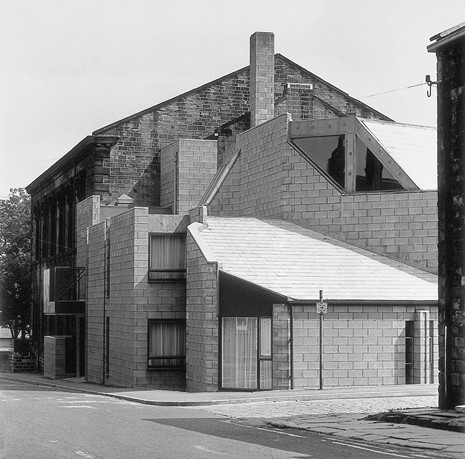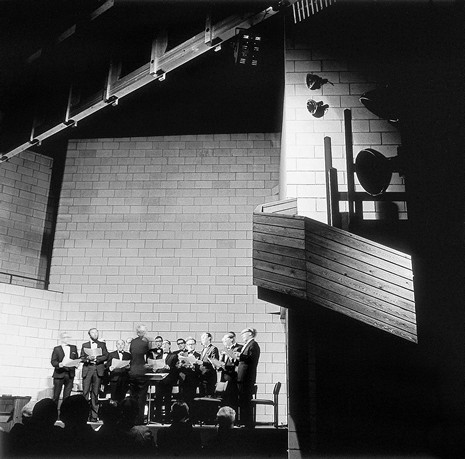Description
In the period between the late sixties and the late seventies almost every church was planned as a community centre. The church is not solely a building for the church service or a vessel for the holy; it is simply the place where believers congregate in the name of Jesus Christ. “A church should be functional” was the motto of the day. Accordingly, the functional programme of church buildings provided spaces for younger and older people to come together not only on Sundays but also on weekdays for all manner of social and cultural activities. No naves, no towers, no processional arrangement, no congregational arrangement: the specifically sacred elements were abandoned in favour of multifunctional or polyfunctional spaces. Many such new spaces – which were also used for Catholics to celebrate the Sacrament or Protestants the Communion – were more akin to a utilitarian lecture room or stage hall, in which a flexible podium and variable seating were the most prominent elements.
Although the community centre approach found favour among both Catholics and Protestants, it was most enthusiastically embraced by Lutheran and Reform church congregations. Avowed Methodists may even have gone a step further, rejecting churches that did not offer spaces for social or communal activities. The Methodist Church arose in the first half of the 18th century as a response to the perceived self-importance of the clergy of the Anglican Church. In principle, Methodism is a denomination of devout preachers, who set up “classes” and “Sunday Schools” in order to spread the word among the burgeoning lower classes. Martin Luther’s belief in “sola fide” (justification by faith alone) and a tremendous commitment to the needs of the working classes went hand in hand. Accordingly, Methodism is most strongly rooted in the cities of the Industrial Revolution in England.
This was the case in Morley, a municipality in west Yorkshire with a population that today numbers some 42,000 inhabitants and is now part of Leeds. Built in 1861, the Central Methodist Church lies in the centre of Morley near to the Main Road and City Hall. The area around the church is dominated by rows of two-storey terraced houses, typical workers’ housing. The church itself is rectangular with a low pitched roof and, on account of its dimensions and pediment gables, bears resemblance to a temple. Quoins, stone window mouldings and cornices on the first and second storeys lend the stonework masonry a certain decorum, which the Methodists tolerated to a degree. The interior can accommodate up to 1000 people.
The annexe adjoins the hall on a free plot to the west and south of the old soot-stained building. The old building and new annexe maintain a critical balance: the annexe occupies some four-tenths of the entire church property; it dominates the corner of two streets on a slight incline; it presents itself as a complex polygon containing different functions, so that the temple behind it – a straightforward pattern-book building of the time – pales somewhat in comparison.
Measuring 19.5 by 20.9 metres, the annexe has a roughly rectangular plan. For the narrow street to the south and west, however, local regulations stipulated that the building should step back three metres and that the corner be cut at 45 degrees. This statutory constraint was undoubtedly generative for the design of the building, in particular the folds of the walls and the creation of a half-octagon in the centre of the plan. Both elevations conform to the modernist ideal of a clear relationship between inside and outside. Accordingly, the entrances are arranged on the very left and right, with the classrooms distributed around the corner, the hall behind it and above. The building is constructed of two leaves of concrete breeze blocks; the exterior-facing blockwork with an additional granite component. The door and window frames are metal and small grey cement roof tiles cover the sloping surfaces of the roof.
The entrance to the annexe is at the end of the long side of the old church. A concrete canopy-like construction – on which a “logo” could be placed – announces the entrance. To the left are an office, wardrobe and toilets, on the right two classrooms, the second of which can only be reached through the first. Straight ahead a ramp leads into the canteen and kitchen, which can serve up to 60 people. All spaces are arranged around the half-octagon of the stage space. The youth club, kitchenette and classrooms on the upper floor follow the same arrangement.
The hall with the stage can seat 250 persons on movable chairs. The angle of two sturdy roof joists made of pine determine one’s perception of the 8.2 metre high space. The stage is at one end, the rest of the floor at the other. The platform of the podium is the same height as the floor level of the canteen behind it. By opening a folding partition, it is possible to combine both spaces. A green-coloured wooden stair stands slightly offset and winds up in an octagonal spiral, leading to the kitchen on the first landing and the youth club canteen on the second landing. Coloured surfaces on the ceiling, sometimes red, sometimes blue, contrast with the pale colour of the breeze blocks. Natural light enters from the side through a series of narrow slots in the wall that reach from floor-to-ceiling and from a larger skew window high up beneath the roof. Artificial lighting is provided by spotlights attached to the roof trusses.
In the early seventies the “Central Methodist Hall” was also used for new forms of church services in which amateur dramatics and concerts played a central role. Nevertheless, buildings like the annexe to the Central Methodist Church have long been the subject of criticism from architects and theologians alike: in ideal conditions, so their argumentation, a community centre can be a “cultural centre with a place of worship“, in worse cases it is simply a “social help centre”. Criticism of this kind disregards the tradition of Methodism and fails to appreciate the breadth of tasks and activities a church congregation undertakes. In cities where fewer and fewer persons attend traditional church services with the Eucharist or Communion, churches can end up facing an unpleasant choice: sell or demolish. When converted appropriately, for whatever kind of religious purpose, such buildings can acquire a character as robust as that of the church in Morley.
The Architects’ Journal, 9. 12. 1970, pp. 1365- | The Architectural Review, no. 10/1970, pp. 255- | Concrete Quarterly, no. 88/1971, pp. 7- | Disse, Rainer: Kirchliche Zentren, Entwurf und Planung, Vol. 24, Munich 1974, p. 12 | AC Internationale Asbestzement-Revue, no. 64/1971, pp. 21
Drawings
Site plan
Axonometric with cutout showing roof truss
Lower floor
Upper floor
Section through the centre of the hall
Northwest elevation
Southwest elevation
Photos

View from the west, on the left the entrance, in the centre one of the class rooms, above it a window above the stage

Junction between the old and new buildings on the southeast side, the canteen below and the youth club above in the projecting volume that overlooks the cemetery, to the right the fire escape
Originally published in: Rudolf Stegers, Sacred Buildings: A Design Manual, Birkhäuser, 2008.